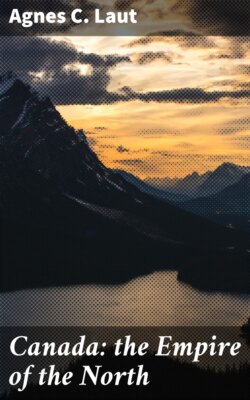Читать книгу Canada: the Empire of the North - Agnes C. Laut - Страница 32
На сайте Литреса книга снята с продажи.
PORT ROYAL OR ANNAPOLIS BASIN, 1609 (From Lescarbot's map)
ОглавлениеHere, then, at last, is founded the first colony in Canada, a little palisaded fort of seventy-nine men straining longing eyes at the sails of the vessel gliding out to sea; for Pontgravé has taken one vessel up the St. Lawrence to trade, and Poutrincourt has gone back to France with the other for supplies. A worse beginning could hardly have been made. The island was little better than a sand heap. No hills shut out the cold winds that swept down the river bed from the north, and the tide carried in ice jam from the south. As the snow began to fall, padding the stately forests with a silence as of death, whitening the gaunt spruce trees somber as funereal mourners, the colonists felt the icy loneliness of winter in a forest chill their hearts. Cooped up on the island by the ice, they did little hunting. Idleness gives time for repinings. Scurvy came, and before spring half the colonists had peopled the little cemetery outside the palisades. De Monts has had enough of Ste. Croix. When Pontgravé comes out with forty more men in June, De Monts prepares to move. Champlain had the preceding autumn sailed south seeking a better site; and now with De Monts he sails south again far as Cape Cod, looking for a place to plant the capital of New France. It is amusing to speculate that Canada might have included as far south as Boston, if they had found a harbor to their liking; but they saw nothing to compare with Annapolis Basin, narrow of entrance, landlocked, placid as a lake, with shores wooded like a park; and back they cruised to Ste. Croix in August, to move the colony across to Nova Scotia, to Annapolis Basin of Acadia. While Champlain and Pontgravé volunteer to winter in the wilderness, De Monts goes home to look after his monopoly in France.
What had De Monts to show for his two years' labor? His company had spent what would be $20,000 in modern money, and all returns from fur trade had been swallowed up prolonging the colony. While Champlain hunted moose in the woods round Port Royal and Pontgravé bartered furs during the winter of 1605–1606, De Monts and Poutrincourt and the gay lawyer Marc Lescarbot fight for the life of the monopoly in Paris and point out to the clamorous merchants that the building of a French empire in the New World is of more importance than paltry profits. De Monts remains in France to stem the tide rising against him, while Poutrincourt and Lescarbot sail on the Jonas with more colonists and supplies for Port Royal.
Noon, July 27, 1606, the ship slips into the Basin of Annapolis. To Lescarbot, the poet lawyer, the scene is a fairyland—the silver flood of the harbor motionless as glass, the wooded meadows dank with bloom, the air odorous of woodland smells, the blue hills rimming round the sky, and against the woods of the north shore the chapel spire and thatch roofs and slab walls of the little fort, the one oasis of life in a wilderness. As the sails rattled down and the anchor dropped, not a soul appeared from the fort. The gates were bolted fast. The Jonas runs up the French ensign. Then a canoe shoots out from the brushwood, paddled by the old chief Membertou. He signals back to the watchers behind the gates. Musketry shots ring out welcome. The ship's cannon answer, setting the waters churning. Trumpets blare. The gates fly wide and out marches the garrison—two lone Frenchmen. The rest, despairing of a ship that summer, have cruised along to Cape Breton to obtain supplies from French fishermen, whence, presently, come Pontgravé and Champlain, overjoyed to find the ship from France. Poutrincourt has a hogshead of wine rolled to the courtyard and all hands fitly celebrate.
